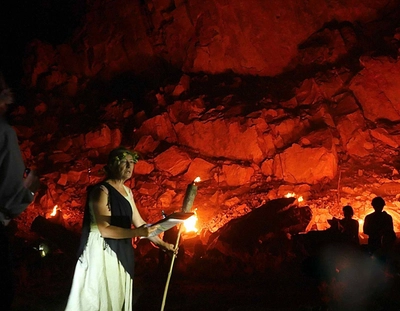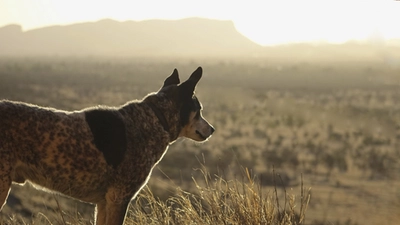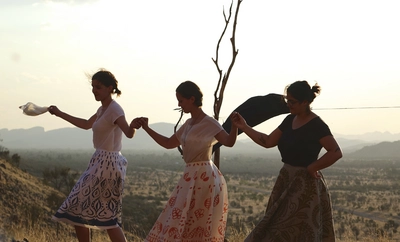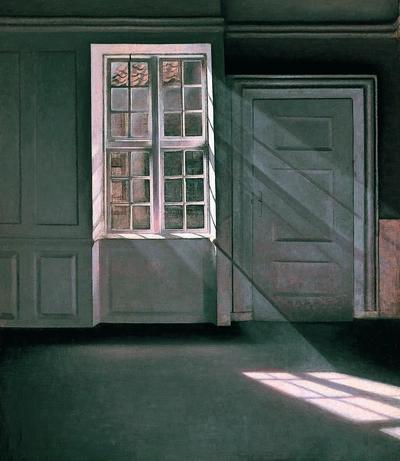ARAS Connections: Image and Archetype - 2016 Issue 2

This Spring I traveled to Australia for the first time. The small town of Alice Springs was at the heart of my trip and sits in the center of Australia. Alice Springs has become an important “contact zone” between indigenous (Aboriginal) and non indigenous peoples. Many agencies dealing with aboriginal affairs are headquartered there. In defining what a “contact zone” is, Mary Louis Pratt wrote that a contact zone is a social space “where cultures meet, clash and grapple with each other, often in contexts of highly asymmetrical relations of power, such as colonialism, slavery, or their aftermaths as they are lived out in many parts of the world today”1. Peter Bishop, writing in his chapter "The Contact Zone as Imaginal Space" in Placing Psyche, goes on to say, "Contact zones also offer spaces where a decolonialising of cross-cultural communication and action can occur, where there can be alternative possibilities."2
This is precisely what I encountered in this unusual community of Australian citizens who have gathered in Alice Springs to engage more vitally with pragmatic intercultural exchange and relationships. Although Alice Springs is a town of only 28,000 people, I witnessed the most amazing display of cross-cultural creativity that I have ever seen. A volunteer group of sensitive people have gathered not only to promote positive relations between indigenous and non indigenous people but to stimulate a fertilization between the oldest mediterranean/middle eastern mythologies and the Aboriginal Altjerre or "The Dreaming". The “alternative possibilities” that are emerging in the contact zone of Alice Springs include contact between ancient and modern cultures, between western and aboriginal mythopoetic modes of thinking and between human beings of good will from two very different worlds. Emerging out of this contact zone are new, meaningful mythic and contemporary pragmatic forms that contribute to what I like to think of as “recombinant visionary mythology”. And the relationships between word, image, and ceremony that result are stunning.
1. M. Pratt, “Arts of the Contact Zone”, in Mass Culture and Everyday Life, ed. P. Gibian (New York: Routledge, 1997), p. 62.
2. P. Bishop, "The Contact Zone as Imaginal Space: The Nullarbor in the Non-indigenous Australian Imagination”, in Placing Psyche: Exploring Cultural Complexes in Australia (eds. Thomas Singer, Craig San Roque, Amanda Dowd and David Tacey (New Orleans: Spring Journal Books, 2011).
Introduction to the Alice Springs’ Performance of Persephone’s Dog
The following three articles are a circumambulation of a unique cultural event that was held in Alice Springs, Australia on September 30, 2015. Craig San Roque has created a modern version of the Demeter/Persephone myth that was at the heart of the Eleusian mysteries, the central form of worship in Greece for 2000 years. Rituals were performed at Eleusis to celebrate the revelation contained within this ancient story. Many believe that this myth marks the transition in Europe from a hunter-gatherer society to an agricultural society. It is for this reason that Craig has focused on the myth of Demeter and Persephone as some Aboriginal people of Australia are attempting to make this transition now and are without any stories to guide them from their own Dreaming. Craig has translated the myth into the cadences and rhythms of Aboriginal story telling. In a remarkable enactment, Craig’s rendering of the Demeter/Persephone myth was performed outside of Alice Spring last year. ARAS Connections wants to bring you the story of this unique performance and has chosen three different ways to tell and show it to you. Kieran Finnane reported the story for the local newspaper and her article is intended to orient you to the event. The second article is Craig’s modern version of the myth along with explanatory introductory notes about his work. And finally, Fiona Walsh tells the story through her sensational photo essay of the actual performance.
A Picnic of Promise

It is as though a mouth in the rockface has been prised open and stomach contents disgorged, teeth too. This is the deepest of the scars left by the quarrying of stone from the range rising along the southern side of Ilparpa Valley. The disgorgement settles on a flattened turnaround for trucks and machinery, high above the valley; a second smaller turnaround has been carved out below. The road leading up to it has eroded into a deep gully; just a goat track at the side holds on, buttressed by buffel grass and rock. Up this track we go, for a picnic of promise.
There is food yes, tables laden with crusty brown loaves, oil for dipping, olives, black and green, luscious yogurt, Mediterranean vegetables and fruits. No wine. Our town has an uneasy relationship with wine. It is banned in public places (in many private places too). Despite unlikely detection, we abstain.
Before we eat we hear the first part of a story of origins, an ancestral creation story for this food culture we so love. ‘We’, what ‘we’ is this? In a place like Alice Springs this is never a simple category. Looking around, at the crowd of loosely connected people, gathered by word of mouth, I can say it is a multi-cultural ‘we’ of recent arrivals whose history here might go back decades, even a generation or two, not longer and for some much shorter. Our ‘we’ also includes a few visitors, family and friends who have come especially and soon will go again.
Read A Picnic of Promise in its entirety.
Introduction to the Kore Story/Persephone's Dog

Imagine original beings walking the earth, archetypal forms in the making, emerging out of the land. Emerging simultaneously from the human psyche. You might ask – am I discovering these beings walking toward me across the land, or am I creating them?
It is a human thing to dream creatures. Yet perhaps not every original being is invented by human beings. Perhaps the force of nature has a life of its own and comes to meet us in forms that nature chooses, firing our imagination as it does so. A special kind of sung poetry has developed among many peoples of the world that mingles the reality that we see with the reality that we create. There may not be one clear term in the English language that describes this intermingling of that which we imagine and that which is independently there. I prefer the term ontopoiesis – or, more simply, ontopoetic – suggesting a mingling of the Greek concept ontos (“that which is” – “I am” or “being”) with poiesis (indicating “coming into being”–“creation” or “bringing forth”).
Together these words ontos and poiesis synchronize into a sense of the poetic, creative relationships between beings. This intermingling is an intricate etymological and psychological matter and my sentence here merely hints at the subtlety of ontopoetics. Let us say that the term draws our attention to the poetic infrastructure of creation, the beauty and symmetry that may be found in the order of an insect, in the structure of seeds, in the composition of bird song, in the camouflage speckle on the skin of trout or deer. And then there is the response that a human being makes to these symmetries, for the human is a part of this design.
Read Introduction to the Kore in its entirety.
Persephone's Dog: A Photo Essay

The Poetry Portal

The word window comes from an Old Norse word meaning “wind eye”. It could be an opening through the roof above the hearth letting the smoke out or a small opening in the wall letting the light of the sun or the moon in. Some of the notions being evoked by “window” concern threshold - between inside and outside, between above and below, the idea of transparency and seeing through. We call the eye a window, allowing us to see into someone’s soul. We hope that you will be inspired to write a poem on the theme of Window for this installment of the Poetry Portal. Please send your poems to poetry@aras.org by September 15, 2016.
A heartfelt thank you to everyone who submitted a poem for the last “Invite to Write,” inspired by the image of Wings. It is always a delight and deeply moving to read your poems.
Contents
Become a Member of ARAS!
Become a member of ARAS Online and you'll receive free, unlimited use of the entire archive of 17,000 images and 20,000 pages of commentary any time you wish—at home, in your office, or wherever you take your computer.
The entire contents of three magnificent ARAS books: An Encyclopedia of Archetypal Symbolism, The Body and The Book of Symbols are included in the archive. These books cost $330 when purchased on their own.
You can join ARAS Online instantly and search the archive immediately. If you have questions, please call (212) 697-3480 or email info@aras.org
We Value Your Ideas
As our newsletter grows to cover both the ARAS archive and the broad world of art and psyche, we're eager to have your suggestions and thoughts on how to improve it. Please send your comments to info@aras.org. We look forward to your input and will reply to every message.
Subscribe
If you're not already a subscriber and would like to receive subsequent issues of this newsletter by email at no cost, e-mail us at newsletter@aras.org.
